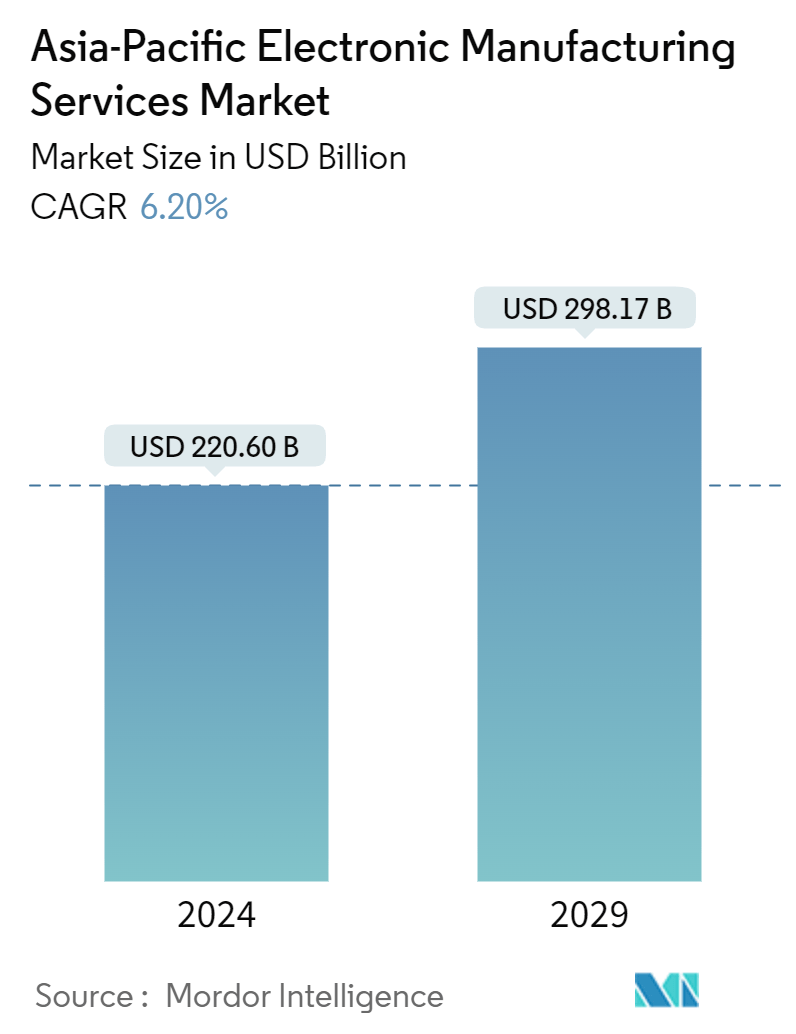Market Size of Asia-Pacific Electronic Manufacturing Services Industry

| Study Period | 2019 - 2029 |
| Base Year For Estimation | 2023 |
| Market Size (2024) | USD 220.60 Billion |
| Market Size (2029) | USD 298.17 Billion |
| CAGR (2024 - 2029) | 6.20 % |
| Market Concentration | Low |
Major Players
*Disclaimer: Major Players sorted in no particular order |
Asia-Pacific Electronic Manufacturing Services Market Analysis
The Asia-Pacific Electronic Manufacturing Services Market size is estimated at USD 220.60 billion in 2024, and is expected to reach USD 298.17 billion by 2029, growing at a CAGR of 6.20% during the forecast period (2024-2029).
Several leading electronics brands worldwide are increasingly moving their manufacturing bases to countries in Asia-Pacific, notably China and India. They are drawn by the region's cost-effective labor, well-established supply chains, and supportive governmental policies. Consequently, this migration fuels a rising need for electronics manufacturing services (EMS) providers in Asia-Pacific. These providers are crucial in bolstering the production of consumer electronics and a wide array of electronic goods.
The trend toward miniaturization has catalyzed a surge in technological innovation. The rise of smaller, more potent components has been pivotal in enabling the Internet of Things (IoT). With these compact designs, devices housing these miniaturized components can shrink in size, enhancing functionality and user experience. Additionally, smaller components typically demand less energy, further bolstering their appeal. Consumer demand is shifting toward smaller, more portable electronic devices, including smartphones, wearables, and IoT gadgets. This trend challenges EMS providers to enhance their manufacturing processes and capabilities to accommodate these intricate electronic components and assemblies.
Further, the manufacturing sector is witnessing a surge in the adoption of IIoT technologies. These technologies empower automation, data-driven decision-making, and heightened operational efficiency. EMS providers are capitalizing on IIoT solutions in the region, including smart sensors, cloud-based analytics, and predictive maintenance. They refine their manufacturing processes, elevate product quality, and curb operational expenses. With IIoT at its core, EMS providers are stepping up to deliver advanced, integrated services, solidifying their stance as favored partners in the worldwide electronics supply chain.
Government initiatives across the region are propelling market growth. In August 2023, India's government passed new regulations requiring companies to secure licenses for importing various products, including laptops, tablets, personal computers, and servers. These regulations aim to enhance trust in imported hardware, reduce import dependence, and stimulate local manufacturing. By ramping up domestic electronics production, India is striving to enhance its technological self-sufficiency, secure critical supply chains, and further its objective of becoming a major electronics manufacturing hub.
However, one of the primary challenges impeding the growth of the Asia-Pacific market is the array of regulatory implications. Businesses in this region must adhere to a spectrum of environmental laws and regulations spanning local, state, federal, and even foreign domains. These regulations cover the manufacturing processes and extend to the storage, treatment, discharge, emission, and disposal of hazardous waste byproducts. Furthermore, lead dust can be a byproduct during the electronics assembly, necessitating companies to address it, even during facility vacating, potentially stalling market growth.
Moreover, Asia-Pacific comprises diverse nations with distinct regulatory frameworks, trade policies, and compliance mandates. EMS providers in this region grapple with comprehending and complying with these varied standards. These standards range from product safety and environmental regulations to data privacy laws, necessitating substantial investments in both time and resources.
Asia-Pacific Electronic Manufacturing Services Industry Segmentation
Electronics manufacturing services are used by organizations that design, manufacture, test, distribute, and provide return and repair services for electronic components and assemblies for original equipment manufacturers (OEMs). The study monitors revenue generated from services offered across multiple applications. It provides a detailed breakdown of market estimates based on service types, applications, and countries in Asia-Pacific.
The Asia-Pacific electronic manufacturing services market is segmented by service type (electronics design and engineering, electronics assembly, electronics manufacturing, and other service types), application (consumer electronics, automotive, industrial, aerospace and defense, healthcare, IT and telecom, and other applications), and country (China, Japan, India, and Rest of Asia-Pacific). The market sizes and forecasts are provided in terms of value (USD) for all the above segments.
| By Service Type | |
| Electronics Design and Engineering | |
| Electronics Assembly | |
| Electronics Manufacturing | |
| Other Service Types |
| By Application | |
| Consumer Electronics | |
| Automotive | |
| Industrial | |
| Aerospace and Defense | |
| Healthcare | |
| IT and Telecom | |
| Other Applications |
| By Country*** | |
| China | |
| Japan | |
| India | |
| South Korea | |
| Taiwan | |
| Australia and New Zealand |
Asia-Pacific Electronic Manufacturing Services Market Size Summary
The Asia-Pacific electronic manufacturing services market is experiencing significant growth, driven by the strategic relocation of global electronics manufacturing bases to the region, particularly in China and India. This shift is largely due to the region's cost-effective labor, robust supply chains, and favorable government policies, which are attracting leading electronics brands. The demand for electronics manufacturing services (EMS) is further bolstered by the trend towards miniaturization and the rise of the Internet of Things (IoT), necessitating advanced manufacturing processes to accommodate smaller, more powerful components. EMS providers are leveraging IIoT technologies to enhance automation, improve product quality, and reduce costs, positioning themselves as key players in the global electronics supply chain. Government initiatives, such as India's regulations to boost local manufacturing and reduce import dependence, are also contributing to market expansion, despite challenges posed by diverse regulatory frameworks across the region.
The consumer electronics segment is a major driver of the EMS market, with increasing demand for sophisticated manufacturing to support advanced technology and features in devices like smartphones, wearables, and IoT gadgets. Rapid urbanization and economic growth in countries like China and India have expanded the middle class, further fueling demand for consumer electronics. Governments in the region are implementing policies to support the electronics manufacturing sector, offering incentives and fostering manufacturing hubs. India, in particular, is poised to become a dominant force in electronics manufacturing, supported by government schemes and a growing domestic market. The competitive landscape is marked by strategic investments and expansions by key players, such as Zetwork and Taiwan Semiconductor Manufacturing Co., as they aim to enhance production capabilities and strengthen their market presence in Asia-Pacific and beyond.
Asia-Pacific Electronic Manufacturing Services Market Size - Table of Contents
-
1. MARKET INSIGHTS
-
1.1 Market Overview
-
1.2 Industry Attractiveness - Porter's Five Forces Analysis
-
1.2.1 Bargaining Power of Suppliers
-
1.2.2 Bargaining Power of Consumers
-
1.2.3 Threat of New Entrants
-
1.2.4 Threat of Substitutes
-
1.2.5 Intensity of Competitive Rivalry
-
-
1.3 An Assessment of Macroeconomic Factors on the Market
-
-
2. MARKET SEGMENTATION
-
2.1 By Service Type
-
2.1.1 Electronics Design and Engineering
-
2.1.2 Electronics Assembly
-
2.1.3 Electronics Manufacturing
-
2.1.4 Other Service Types
-
-
2.2 By Application
-
2.2.1 Consumer Electronics
-
2.2.2 Automotive
-
2.2.3 Industrial
-
2.2.4 Aerospace and Defense
-
2.2.5 Healthcare
-
2.2.6 IT and Telecom
-
2.2.7 Other Applications
-
-
2.3 By Country***
-
2.3.1 China
-
2.3.2 Japan
-
2.3.3 India
-
2.3.4 South Korea
-
2.3.5 Taiwan
-
2.3.6 Australia and New Zealand
-
-
Asia-Pacific Electronic Manufacturing Services Market Size FAQs
How big is the Asia-Pacific Electronic Manufacturing Services Market?
The Asia-Pacific Electronic Manufacturing Services Market size is expected to reach USD 220.60 billion in 2024 and grow at a CAGR of 6.20% to reach USD 298.17 billion by 2029.
What is the current Asia-Pacific Electronic Manufacturing Services Market size?
In 2024, the Asia-Pacific Electronic Manufacturing Services Market size is expected to reach USD 220.60 billion.

